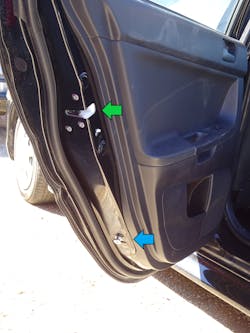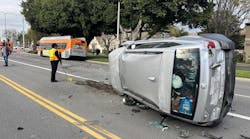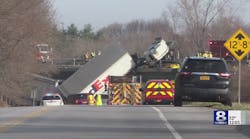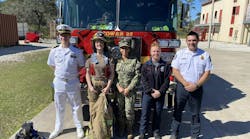Topic: Door striker pin and striker plate
Objective: The rescue team shall understand the function of the door striker pin and striker plate
Task: The rescue team shall develop and implement a protocol for evaluating and opening a crash-damaged vehicle door when the door striker pin and striker plate are present
When confronted with a vehicle door at a crash scene that doesn’t open readily, rescuers typically are called upon to “force” open the door, so occupants can be removed more readily. To do this most efficiently, the rescue team that works the jammed-door task must fully understand what they are up against and be aware of what actually is keeping the door from opening.
Two little-known door components play roles in both the normal functionality of a vehicle door and a door that’s jammed at a crash scene.
Latch/lock vs. pin/plate
Two familiar door components that rescue teams deal with are the safety latch, which usually is at the end of the door itself, and the safety lock, which usually is secured to the structure of the vehicle. We’ll use the term safety latch for the unit that’s mounted inside of the door cavity, because moving cogs that are inside of this assembly actually grab the safety lock component to hold the door closed. The safety lock component, which generally is on the body of the vehicle, is a nonmoveable pin, bolt or horseshoe-shaped feature that mates with the safety latch to secure the door closed. (Manufacturers might utilize these or other names for the components.)
What is critical to note is that two additional door components might be present on a crash-damaged vehicle: the striker pin and the striker plate. Because they might be incorrectly referred to as a second safety latch/safety lock assembly, rescuers can be confused. Rescue officers and extrication instructors should be able to identify the striker pin and striker plate and be familiar with the role that they play.
The door striker pin typically is a hardened steel pin or bolt that sticks out from the end or edge of the door itself. As the door of the vehicle closes, the striker pin mates with the door striker plate. As the striker plate component receives the striker pin, it aligns with the pin and allows the door to seat properly when closed. This mating of the striker pin and striker plate assures that the door closes fully and has a snug fit against the trim pieces or door gasket material there.Where confusion comes is the misconception that the striker pin/striker plate assembly actually hold the door closed in a similar fashion to the safety latch/safety lock assembly. The safety latch/safety lock assembly remains as the primary system that keeps a vehicle door closed. The door striker pin and striker plate, when present, are designed only to mate together and to allow the door to close snugly.
The door-opening sequence
When encountering a jammed door, it won’t be the striker pin or striker plate that fights door-opening efforts. They won’t grab and hold the door closed. The focus of jammed-door prying, spreading or cutting should be working to free the safety lock from its receiver mechanism—the safety latch.
Jammed doors also can be prevented from opening for other reasons, such as when a piece of the door’s full-frame window structure is crushed by a body panel or when a fender overlaps the door enough to hold the door closed. However, the connection that’s between the safety latch and safety lock is most significant.
The recommended door-opening sequence begins when you initially approach the door. The rescue crew must first assess, or size up, the door. That is followed by setting up the door. The final step involves opening up the door.
A rescuer who is in too much of a hurry often skips to the third step. This lack of discipline might increase the overall time that’s spent completing the task.Several commonsense considerations for sizing up the door include determining whether the door is locked or unlocked. An unlocked door might open a lot easier and faster than one that’s locked. Ask yourself during your initial size-up why the door doesn’t open right now. Have you tried the outside handle as well as the inside handle? (The outer handle might be damaged, while the inside handle still might work.) Is there a portion of the body of the vehicle that keeps the door from opening?
After size-up, the work continues with setting up the door. Crewmembers must determine whether there is a readily available or existing purchase point that allows for a latch-side or hinge-side attack. If a purchase point is needed, you must create one by using your training and the proper tool(s). Ask yourself, “Will my spreader or cutting tool get into where I want it to go?” If not, then the door isn’t set up yet.
Once an effective size-up is completed and a good purchase point is made, it all boils down to applying rescue tools to force or cut open the door. If during the opening process, you discover a striker pin/striker plate assembly, you should anticipate that the assembly’s components will slide separate during the door-opening process.
Keep your rescue efforts concentrated on stressing the safety lock and safety latch until they fail. Once cut free or forced to the point of failure, the striker pin and striker plate will separate from each other as the door is opened or removed, and this phase of your door-opening task is completed. Door widening or total removal might follow, depending on crash-scene conditions and the patient’s location.









